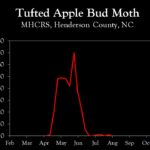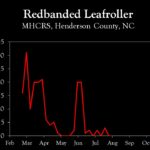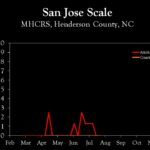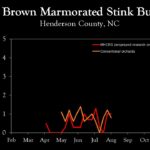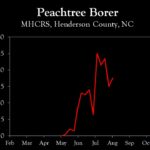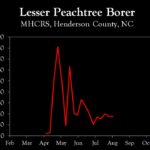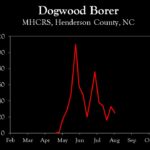WNC Orchard Insect Pest Populations – August 5, 2025
go.ncsu.edu/readext?1086684
en Español / em Português
El inglés es el idioma de control de esta página. En la medida en que haya algún conflicto entre la traducción al inglés y la traducción, el inglés prevalece.
Al hacer clic en el enlace de traducción se activa un servicio de traducción gratuito para convertir la página al español. Al igual que con cualquier traducción por Internet, la conversión no es sensible al contexto y puede que no traduzca el texto en su significado original. NC State Extension no garantiza la exactitud del texto traducido. Por favor, tenga en cuenta que algunas aplicaciones y/o servicios pueden no funcionar como se espera cuando se traducen.
Português
Inglês é o idioma de controle desta página. Na medida que haja algum conflito entre o texto original em Inglês e a tradução, o Inglês prevalece.
Ao clicar no link de tradução, um serviço gratuito de tradução será ativado para converter a página para o Português. Como em qualquer tradução pela internet, a conversão não é sensivel ao contexto e pode não ocorrer a tradução para o significado orginal. O serviço de Extensão da Carolina do Norte (NC State Extension) não garante a exatidão do texto traduzido. Por favor, observe que algumas funções ou serviços podem não funcionar como esperado após a tradução.
English
English is the controlling language of this page. To the extent there is any conflict between the English text and the translation, English controls.
Clicking on the translation link activates a free translation service to convert the page to Spanish. As with any Internet translation, the conversion is not context-sensitive and may not translate the text to its original meaning. NC State Extension does not guarantee the accuracy of the translated text. Please note that some applications and/or services may not function as expected when translated.
Collapse ▲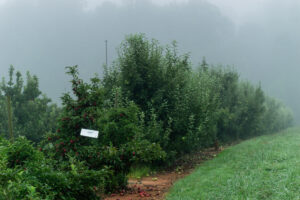 The recent cool weather has slowed insect development, and consequently not much has changed in the past week. Codling moth, brown marmorated stink bug (BMSB), and apple maggot remain the key pests of concern, but the threat to individual orchards varies considerably depending on location and level of management employed during the season.
The recent cool weather has slowed insect development, and consequently not much has changed in the past week. Codling moth, brown marmorated stink bug (BMSB), and apple maggot remain the key pests of concern, but the threat to individual orchards varies considerably depending on location and level of management employed during the season.
Codling moth/Oriental fruit moth (OFM): Overall, populations and damage are very low in most managed orchards, but damaged fruit is not uncommon in orchards that have had reduced pesticide inputs due to poor crops. Unfortunately, damage also has been observed in a few managed orchards, and judging by the size of the largest larvae, they were likely the result of egg laying in mid to late June, which was the latter part of the first generation. The vast majority of larvae we have dissected from fruit have been codling moth.
Apple Maggot: Fly captures on baited traps continue to be high at our abandoned orchard site, while numbers remain very low in managed orchards. Pyrethroids applied for BMSB (see below) will control AM. If pyrethroids are not necessary for BMSB, Admire (or a generic imidacloprid product) will also provide good control of apple maggot.
BMSB: The cool and rainy weather has suppressed BMSB activity, but as temperatures increase later this week activity will probably pick up. In Henderson County, almost 800 degree days (DD) have accumulated since biofix, which the model predicts is equivalent to emergence of about 15% of the F1 adult population. Based on the weather forecast, DD accumulations will increase to about 840 by early next week, or emergence of 25% of adults. Hence, an insecticide on susceptible cultivars when the rain lets up is recommended. In Cleveland County, emergence of F1 adults is about 60% complete, so hopefully an application has been made by this time.
Below are results of a study conducted in 2022 that show the relative susceptibility of different cultivars to BMSB. The bottom line of this work was that time of harvest, opposed to cultivar, was the most important factor determining susceptibility. Any cultivar harvested in September or October was equally susceptible to BMSB, and only those cultivars harvested before September (Ginger Gold and Gala) escaped significant damage.
BMSB Damage to Apple Cultivars is Related to Harvest Date
2025 Average Weekly Trap Captures
| HENDERSON COUNTY | |||
| Insects per trap | |||
| Jul 21 | Jul 28 | Aug 4 | |
| Codling moth | 1.0 | 2.5 | 1.5 |
| Oriental fruit moth | 17.0 | 10.0 | 9.0 |
| Tufted apple bud moth | 0.0 | 1.0 | 0.0 |
| Redbanded leafroller | 3.0 | 0.0 | 0.0 |
| Obliquebanded leafroller | 3.0 | 0.0 | 2.0 |
| Lesser appleworm | 0.0 | 0.0 | 0.0 |
| Apple maggot (unsprayed research orchards) | 0.0 | 0.0 | 0.0 |
| Apple maggot (abandoned orchard) | 19.0 | 29.0 | 18.0 |
| Brown marmorated stink bug (commercial orchards) | 0.8 | 1.2 | 0.8 |
| Brown marmorated stink bug (unsprayed research orchards) | 0.0 | 1.0 | 0.0 |
| Spotted tentiform leafminer | 0.0 | 0.0 | 0.0 |
| Dogwood borer | 16.0 | 33.0 | 25.0 |
| Peachtree borer | 23.5 | 15.0 | 17.5 |
| Lesser peachtree borer | 20.0 | 17.5 | 17.5 |
| San Jose scale | 1.3 | 0.0 | 0.0 |
*Note that these averages illustrate only the timing of insect emergence and fluctuations in populations, and are not representative of population levels in any given orchard. The only way to have an accurate assessment of an individual orchard’s populations is to set up traps in that orchard.
2025 Accumulated Degree Days
| HENDERSON COUNTY | ||||
| Jul 21 | Jul 28 | Aug 4 | ||
| Codling moth (Biofix: April 21) | 1757 | 1944 | 2120 | |
| Oriental fruit moth (Biofix: March 17) | 2583 | 2799 | 2999 | |
| Tufted apple bud moth (Biofix: April 14) | 2261 | 2476 | 2677 | |






